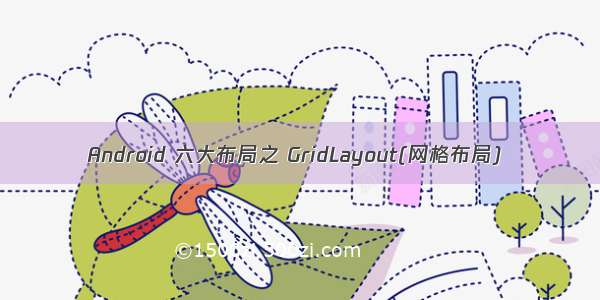
文章目录
安卓六大布局线性布局(LinearLayout)线性布局常用的属性android:layout_weight 属性的一些说明分割线设置线性布局示例相对布局(RelativeLayout)相对布局的一些常用属性有:按父容器定位示意图按兄弟组件定位示意图margin与padding的区别相对布局示例表格布局 (TableLayout)常用属性如何确定所需的行数和列数表格布局的示例帧布局(FrameLayout)常用属性帧布局示例网格布局(GridLayout)常用属性用法归纳网格布局示例绝对布局(AbsoluteLayout)常用属性安卓六大布局
线性布局(LinearLayout)
在线性布局中,每一行(针对垂直排列)或每一列(针对水平排列)中只能放一个组件,Android的线性布局不会换行,当组件排列到窗体边缘后,后面的组件不会被显示出来。
线性布局常用的属性
其中android:layout_width、android:layout_height、android:layout_weight是ViewGroup.LayoutParams所支持的XML属性,因此在Java代码中设置这些属性值时,一般需要这样声明:
setLayoutParams(new LayoutParams(LayoutParams.FILL_PARENT,LayoutParams.WRAP_CONTENT, 1));
android:layout_weight 属性的一些说明
设置android:layout_width="0dp"和android:layout_width="wrap_content"属性下如果在设置这个属性的情况下,即自适应和无宽度情况下再设置android:layout_weight属性时使用是比较容易理解的,我们设置比重值后,组件会根据自身的大小结合我们的比重值加上 LinearLayout的orientation是水平还是竖直,决定哪个方向等比例划分
<LinearLayout xmlns:android="/apk/res/android" xmlns:tools="/tools" android:id="@+id/LinearLayout1" android:layout_width="match_parent" android:layout_height="match_parent" android:orientation="horizontal"> <LinearLayout android:layout_width="0dp" android:layout_height="fill_parent" android:background="#ADFF2F"android:layout_weight="1"/> <LinearLayout android:layout_width="0dp" android:layout_height="fill_parent" android:background="#DA70D6"android:layout_weight="2"/> </LinearLayout>
2. 而在设置android:layout_width="match_parent"后,则需要进行计算,为什么需要计算呢?我们来看这个例子
<LinearLayout xmlns:android="/apk/res/android"android:id="@+id/LinearLayout1"android:layout_width="match_parent"android:layout_height="match_parent" ><TextViewandroid:layout_weight="1"android:layout_width="fill_parent"android:layout_height="fill_parent"android:text="梧枝绿"android:background="#69a794"/><TextViewandroid:layout_weight="2"android:layout_width="fill_parent"android:layout_height="fill_parent"android:text="石绿"android:background="#57c3c2"/><TextViewandroid:layout_weight="3"android:layout_width="fill_parent"android:layout_height="fill_parent"android:text="three"android:background="#FF00FF"/></LinearLayout>
看到这里您应该就明白了为什么要计算,明明设置了三个组件按1:2:3划分的为什么只出现了一个?这里其实没那么简单的,还是需要我们计算的,这里给出一个算法:
个个组件都是fill_parent,但是屏幕只有一个,那么1 - 3 = - 2 fill_parent依次比例是1/6,2/6,3/6先到先得,先分给one,计算: 1 - 2 * (1/6) = 2/3 fill_parent 接着到two,计算: 1 - 2 * (2/6) = 1/3 fill_parent 最后到three,计算 1 - 2 * (3/6) = 0 fill_parent所以最后的结果是:one占了两份,two占了一份,three什么都木有 以上就是为什么three没有出现的原因了
可能你还有点懵,我们再来看一个例子,这次我们按照2:3:4比例划分,按照上述步骤计算:
2-4=-2 fill_parent,每个部分比例依次为:2/9,3/9,4/9,第一部分应得1-2*(2/9)=5/9fill_parent,同理第二部分为3/9fill_parent,第三部分为1/9fill_parent,实际划分效果为5:3:1
分割线设置
直接设置直接在布局中添加一个view,这个view的作用仅仅是显示出一条线
<View android:layout_width="match_parent" android:layout_height="1px" android:background="#000000" />
使用LinearLayout的一个divider属性,直接为LinearLayout设置分割线
<LinearLayout xmlns:android="/apk/res/android"android:id="@+id/LinearLayout1"android:layout_width="match_parent"android:layout_height="match_parent"android:divider="@drawable/ktv_line_div"android:orientation="vertical"android:showDividers="middle"android:dividerPadding="10dp"><Buttonandroid:layout_width="wrap_content"android:layout_height="wrap_content"android:text="按钮1" /><Buttonandroid:layout_width="wrap_content"android:layout_height="wrap_content"android:text="按钮2" /><Buttonandroid:layout_width="wrap_content"android:layout_height="wrap_content"android:text="按钮3" /></LinearLayout>
线性布局示例
<?xml version="1.0" encoding="utf-8" ?><LinearLayout xmlns:android="/apk/res/android"xmlns:tools="/tools"android:layout_width="match_parent"android:layout_height="match_parent"android:orientation="vertical"android:id="@+id/layout"tools:context=".MainActivity"><Buttonandroid:text="按钮1"android:id="@+id/bt1"android:layout_width="match_parent"android:layout_height="wrap_content"/><Buttonandroid:text="按钮2"android:id="@+id/bt2"android:layout_width="match_parent"android:layout_height="wrap_content"/><Buttonandroid:text="按钮3"android:id="@+id/bt3"android:layout_width="match_parent"android:layout_height="wrap_content"/><Buttonandroid:text="按钮4"android:id="@+id/bt4"android:layout_width="match_parent"android:layout_height="wrap_content"/></LinearLayout>
线性布局的优势是它的weight(权重)属性,等比例划分,对屏幕适配还是帮助蛮大的;但是使用LinearLayout的时候也有一个问题,就是当界面比较复杂的时候,需要嵌套多层的 LinearLayout,这样就会降低UI Render的效率(渲染速度),而且如果是listview或者GridView上的 item,效率会更低,另外太多层LinearLayout嵌套会占用更多的系统资源,还有可能引发stackoverflow
以上这些说明了线性布局的局限性,如果需要更灵活的布局建议采用相对布局(RelativeLayout)
一般来说在实际的开发中,线性布局单独使用较少,因为它对于屏幕的适配不够灵活,通常用作一些简单的布局或者是其他布局中的嵌入布局。
当 android:orientation=“vertical” 时, 只有水平方向的设置才起作用,垂直方向的设置不起作用。 即:left,right,center_horizontal 是生效的。 当 android:orientation=“horizontal” 时, 只有垂直方向的设置才起作用,水平方向的设置不起作用。 即:top,bottom,center_vertical 是生效的。
相对布局(RelativeLayout)
相对布局是指按照组件之间的相对位置来进行布局,如某个组件在另一个组件的左边、右边、上方或下方等。
相对布局的一些常用属性有:
基本属性
根据父容器定位
根据兄弟组件定位
margin(设置组件与父容器的边距又称为偏移)
padding(设置组件内部元素间的间距)
按父容器定位示意图
按兄弟组件定位示意图
所谓的兄弟组件就是处于同一层次容器的组件,如图中的组件1,2就是兄弟组件了,而组件3与组件1或组件2并不是兄弟组件,所以组件3不能通过 组件1或2来进行定位,比如layout_toleftof = "组件1"这样是会报错的!
margin与padding的区别
首先margin代表的是偏移,比如marginleft = "5dp"表示组件离容器左边缘偏移5dp; 而padding代表的则是填充,而填充的对象针对的是组件中的元素,比如TextView中的文字 比如为TextView设置paddingleft = “5dp”,则是在组件里的元素的左边填充5dp的空间! margin针对的是容器中的组件,而padding针对的是组件中的元素,要区分开来!
设置margin的时候都习惯了是正数的, 其实是可以用负数的,代表相反的偏移
相对布局示例
<?xml version="1.0" encoding="utf-8" ?><RelativeLayout xmlns:android="/apk/res/android"android:id="@+id/relativelayout"android:layout_width="match_parent"android:layout_height="match_parent"android:foregroundGravity="bottom|right"><!--一个居中显示的文本视图textView1--><TextViewandroid:text="发现新版本,您想现在就进行安装吗?"android:id="@+id/textView01"android:textSize="24px"android:layout_width="wrap_content"android:layout_height="wrap_content"android:layout_centerInParent="true"/><!--一个在button2左侧显示的按钮button1--><Buttonandroid:text="立即更新"android:id="@+id/btn1"android:layout_width="wrap_content"android:layout_height="wrap_content"android:layout_below="@+id/textView01"android:layout_toLeftOf="@+id/btn2"/><Buttonandroid:text="稍后再说"android:id="@+id/btn2"android:layout_width="wrap_content"android:layout_height="wrap_content"android:layout_alignRight="@+id/textView01"android:layout_below="@+id/textView01"/></RelativeLayout>
线性布局和相对布局是最常用的两种布局方式了,一定要多了解使用
表格布局 (TableLayout)
表格布局以行、列的形式来管理放入其中的UI组件。表格布局使用使用标记定义,在表格布局中,可以添加多个标记,每个 标记占用一行。由于标记也是容器,所以还可在该标记中添加其他组件,每添加一个组件,表格就会增加一列。在表格布局中,列可以被隐藏,也可以被设置为伸展的,从而填充可利用的屏幕空间,还可以设置为强制收缩,直到表格匹配屏幕大小。
老规矩先来看常用属性
常用属性
如何确定所需的行数和列数
如果我们直接往TableLayout中添加组件的话,那么这个组件将占满一行!!!如果我们想一行上有多个组件的话,就要添加一个TableRow的容器,把组件都丢到里面!tablerow中的组件个数就决定了该行有多少列,而列的宽度由该列中最宽的单元格决定tablerow的layout_width属性,默认是fill_parent的,我们自己设置成其他的值也不会生效!!! 但是layout_height默认是wrap_content的,我们却可以自己设置大小!整个表格布局的宽度取决于父容器的宽度(占满父容器本身)有多少行就要自己数啦,一个tablerow一行,一个单独的组件也一行!多少列则是看tableRow中 的组件个数,组件最多的就是TableLayout的列数
表格布局的示例
<?xml version="1.0" encoding="utf-8" ?><TableLayout xmlns:android="/apk/res/android"android:id="@+id/tablelayout"android:layout_width="match_parent"android:layout_height="match_parent"android:orientation="vertical"android:gravity="center_vertical"android:stretchColumns="0,3"><TableRowandroid:id="@+id/tableRow01"android:layout_width="wrap_content"android:layout_height="wrap_content"><TextView/><TextViewandroid:text="用户名"android:id="@+id/textView1"android:textSize="24px"android:layout_height="wrap_content"android:layout_width="wrap_content"/><EditTextandroid:id="@+id/editText1"android:textSize="24px"android:layout_height="wrap_content"android:layout_width="wrap_content"android:minWidth="200px"/><TextView/></TableRow><TableRowandroid:id="@+id/tableRow02"android:layout_width="wrap_content"android:layout_height="wrap_content"><TextView/><TextViewandroid:text="密码"android:id="@+id/textView2"android:textSize="24px"android:layout_height="wrap_content"/><EditTextandroid:id="@+id/editText2"android:textSize="24px"android:layout_height="wrap_content"android:layout_width="wrap_content"android:inputType="textPassword"/><TextView/></TableRow><TableRowandroid:id="@+id/tableRow03"android:layout_width="wrap_content"android:layout_height="wrap_content"><TextView/><Buttonandroid:text="登录"android:id="@+id/btn02"android:layout_height="wrap_content"android:layout_width="wrap_content"/><Buttonandroid:text="退出"android:id="@+id/btn01"android:layout_height="wrap_content"android:layout_width="wrap_content"/><TextView/></TableRow></TableLayout>
实际开发中表格布局的使用较少,了解一些基本的几个属性即可
帧布局(FrameLayout)
帧布局可以说是六大布局中最为简单的一个布局,这个布局直接在屏幕上开辟出一块空白的区域,通常称为一帧,当我们往里面添加控件的时候,会默认把他们放到这块区域的左上角,而这种布局方式却没有任何的定位方式,所以它应用的场景并不多;帧布局的大小由控件中最大的子控件决定,如果控件的大小一样大的话,那么同一时刻就只能看到最上面的那个组件!后续添加的控件会覆盖前一个!虽然默认会将控件放置在左上角,但是我们也可以通过layout_gravity属性,指定到其他的位置
常用属性
帧布局示例
<?xml version="1.0" encoding="utf-8" ?><FrameLayout xmlns:android="/apk/res/android"android:id="@+id/framelayout"android:layout_width="match_parent"android:layout_height="match_parent"android:foregroundGravity="bottom|right"><TextViewandroid:text="红色背景的TextView"android:id="@+id/textView01"android:background="#FFF00000"android:layout_gravity="center"android:layout_width="400px"android:layout_height="400px"/><TextViewandroid:text="橙色背景的TextView"android:id="@+id/textView02"android:background="#FFFF6600"android:layout_gravity="center"android:layout_width="300px"android:layout_height="300px"/><TextViewandroid:text="黄色背景的TextView"android:id="@+id/textView03"android:background="#FFFFEE00"android:layout_gravity="center"android:layout_width="200px"android:layout_height="200px"/></FrameLayout>
帧布局在实际开发中使用也就比表格布局多一点,也是不常用的布局
网格布局(GridLayout)
网格布局是Android 4.0以后引入的一个新的布局,相较于表格布局更加灵活,我个人认为网格布局才更像表格布局这一概念:可以自己设置布局中组件的排列方式、自定义网格布局有多少行,多少列、直接设置组件位于某行某列、设置组件横跨几行或者几列。
常用属性
用法归纳
先定义组件的对其方式 android:orientation 水平或者竖直,设置多少行与多少列设置组件所在的行或者列,记得是从0开始算的,不设置默认每个组件占一行一列设置组件横跨几行或者几列;设置完毕后,需要在设置一个填充:android:layout_gravity = “fill”如果直接将组件添加到网格布局中,则默认每个组件都是 占一行一列
如果需要让组件填满横越过的行或列的话,需要添加下面这个属性: android:layout_gravity = “fill”
网格布局示例
<GridLayout xmlns:android="/apk/res/android"android:id="@+id/GridLayout1"android:layout_width="wrap_content"android:layout_height="wrap_content"android:columnCount="4"android:orientation="horizontal"android:rowCount="6" ><TextViewandroid:layout_columnSpan="4"android:layout_gravity="fill"android:layout_marginLeft="5dp"android:layout_marginRight="5dp"android:background="#FFCCCC"android:text="0"android:textSize="50sp" /><Buttonandroid:layout_columnSpan="2"android:layout_gravity="fill"android:text="回退" /><Buttonandroid:layout_columnSpan="2"android:layout_gravity="fill"android:text="清空" /><Button android:text="+" /><Button android:text="1" /><Button android:text="2" /><Button android:text="3" /><Button android:text="-" /><Button android:text="4" /><Button android:text="5" /><Button android:text="6" /><Button android:text="*" /><Button android:text="7" /><Button android:text="8" /><Button android:text="9" /><Button android:text="/" /><Buttonandroid:layout_width="wrap_content"android:text="." /><Button android:text="0" /><Button android:text="=" /></GridLayout>
绝对布局(AbsoluteLayout)
绝对布局比起前面的五个布局可以说是最冷门的布局了,说是被淘汰的布局也不为过,相较于相对布局它实在是太不灵活了。举个例子,假如我们在一个4.4英寸的设备上开发了一款适合于这个屏幕比例的APP,然后我们将它部署到5英寸的设备上后,布局会变得混乱,有些组件会产生偏移和变形的现象,而相对布局则不会这样,所以在实际开发中还是建议使用相对布局多一点比较好,绝对布局你就当额外的技术了解一下即可。














